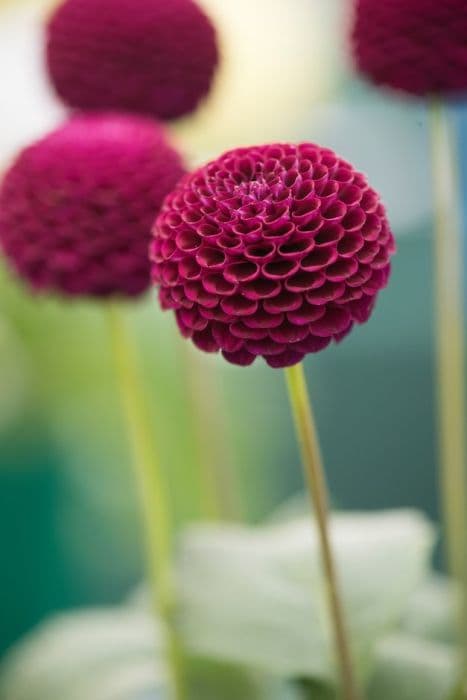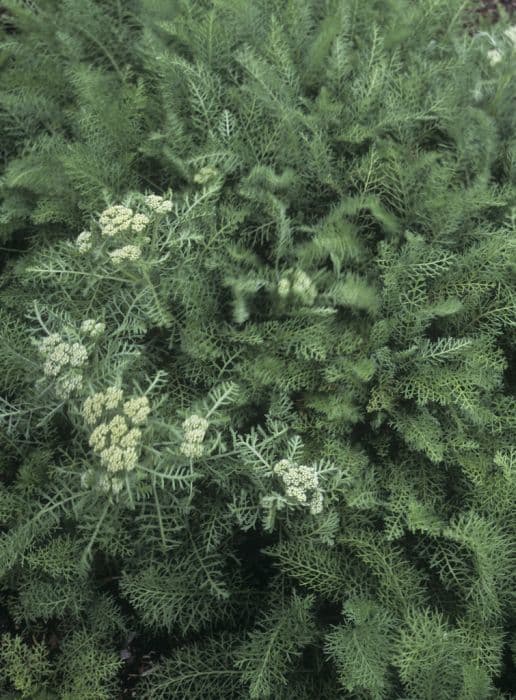Dahlia Dahlia 'Moor Place' (Pom)

ABOUT
The Dahlia 'Moor Place' features a stunning display of flowers that are sure to catch the eye in any garden setting. The blooms are characterized by their distinctive pompon shape, which means they are almost spherical in form with tightly layered petals that create a honeycomb-like appearance. The petals are beautifully curved inward to form a tight ball, demonstrating a high level of geometric precision. The flowers themselves boast a rich color palette, often displaying vibrant hues that can include shades of purple, lavender, or burgundy, which can create a dramatic contrast against the backdrop of green foliage. This foliage, typically deep green in color, serves as a lush canvas that accentuates the vivid colors of the pompon flowers. The leaves are usually oval-shaped with pointed ends and possess a slightly serrated edge, which adds texture and visual interest to the overall appearance of the plant. As a member of the Dahlia family, the 'Moor Place' variety shares the common features of sturdy stems and a robust structure that supports the weight of the showy blooms. The individual flowers are sizable and make an excellent focal point in cut flower arrangements or as a standout feature in garden beds and borders. This Dahlia is a favorite among enthusiasts and gardeners alike, both for its aesthetic qualities and for the joy it brings in caring for and observing its growth throughout the blooming season.
About this plant
 Names
NamesSynonyms
Dahlia, Garden Dahlia, Pompon Dahlia
Common names
Dahlia 'Moor Place'.
 Toxicity
ToxicityTo humans
Dahlias, including the Dahlia 'Moor Place' Pom variety, are generally considered non-toxic to humans. They are not known to contain substances that are poisonous if ingested. Consequently, there are typically no toxic symptoms associated with ingesting dahlias. However, as with any non-food plant, individual sensitivities such as mild stomach upset or allergic reactions may occur in some individuals.
To pets
Dahlias, including Dahlia 'Moor Place' Pom, are also generally considered non-toxic to pets. They are not known to cause serious illness or pose a significant risk of poisoning to animals such as dogs and cats. If a pet were to ingest parts of a dahlia plant, they might experience mild gastrointestinal upset, but no severe toxicity symptoms are typically expected.
 Characteristics
CharacteristicsLife cycle
Perennials
Foliage type
Deciduous
Color of leaves
Green
Flower color
Varies
Height
3-4 feet (0.91-1.22 meters)
Spread
2-3 feet (0.61-0.91 meters)
Plant type
Bulb
Hardiness zones
8
Native area
Mexico
Benefits
 General Benefits
General Benefits- Ornamental Appeal: Dahlia 'Moor Place' brings vibrant colors and dramatic shapes to gardens, enhancing visual interest.
- Versatility in Landscaping: Can be used in borders, flowerbeds, or as a focal point in garden designs.
- Pollinator Attraction: Attracts bees, butterflies, and other beneficial pollinators, promoting biodiversity.
- Cut Flower Use: Ideal for creating bouquets and floral arrangements, with long-lasting blooms.
- Seasonal Interest: Provides late summer to fall interest, when many other plants have finished blooming.
- Easy to Grow: Generally easy to care for, making it suitable for both experienced and novice gardeners.
- Variety of Forms and Colors: Offers a wide range of colors and petal shapes to satisfy personal tastes and garden themes.
- Participation in Shows: Popular for exhibiting in horticultural shows due to their impressive blooms.
 Medical Properties
Medical PropertiesThis plant is not used for medical purposes.
 Air-purifying Qualities
Air-purifying QualitiesThis plant is not specifically known for air purifying qualities.
 Other Uses
Other Uses- Dahlia petals can be used for natural dye. The vibrant hues of 'Moor Place' petals can impart rich color to fabrics or crafts.
- The tubers of dahlia can be eaten like a root vegetable. Though not commonly done with 'Moor Place,' it is possible to cook and eat them like potatoes.
- Dahlia flowers can be crystallized and used as edible decorations. An unusual twist for culinary garnishing, particularly for desserts.
- As a source of inspiration, artists may use dahlia 'Moor Place' for still life painting. The complex structure and color can pose a challenging subject for artists to capture.
- Dahlia blooms can be used in flower jewelry. The petals of 'Moor Place' can be dried and preserved in resin to create unique pendants or earrings.
- In photography, the intricate patterns of dahlia 'Moor Place' can serve as an interesting macro photography subject, showcasing details not seen by the naked eye.
- Dahlias can act as a natural pest repellent in gardens. Planting 'Moor Place' amongst vegetable patches could help deter certain pests.
- As a teaching tool, dahlias like 'Moor Place' can help in biology education to explain plant reproductive systems given their complex flower structure.
- Dahlia flowers can be used in bath bombs. The petals of 'Moor Place' can add a touch of luxury and color to homemade skincare products.
- The stems of dahlias can be used in basket weaving. While not a traditional material, the fibrous stems of 'Moor Place' might be an innovative addition to handcrafted baskets.
Interesting Facts
 Feng Shui
Feng ShuiThe Dahlia is not used in Feng Shui practice.
 Zodiac Sign Compitability
Zodiac Sign CompitabilityThe Dahlia is not used in astrology practice.
 Plant Symbolism
Plant Symbolism- Elegance and Dignity: Dahlias, known for their intricate petals and striking beauty, often represent elegance and dignity, reflecting their sophisticated bloom structure.
- Change and Diversity: The vast variety of dahlia colors and forms symbolize change and diversity, encouraging embracing of new perspectives and experiences.
- Commitment and Bond that Lasts Forever: Because dahlias continue to bloom for extended periods, they are often associated with commitment and an enduring bond between people.
- Inner Strength: Dahlias can also symbolize inner strength, standing out as a source of inspiration and personal growth due to their robust nature.
- Creative Expression: The flamboyant appearance of dahlias is frequently linked to creativity and the expression of one's true self without reservations.
 Water
WaterDahlias should be watered deeply to encourage strong root growth, generally receiving about 1 inch of water per week. During the growing season, if there is no rain, this means watering with about 0.6 gallons per square foot every week. If the weather is particularly hot or dry, increase the frequency to twice a week but avoid overwatering as dahlias do not like to sit in soggy soil. The best method is to use a soaker hose or drip irrigation to deliver water directly to the base of the plant without wetting the foliage, which can lead to fungal diseases.
 Light
LightDahlias thrive in a location that receives full sun, which means at least 6 to 8 hours of direct sunlight daily. They perform best when they get morning sun and some shade during the hottest part of the afternoon, especially in warmer climates. Planting them in a spot that is too shaded will result in fewer blooms and weak growth.
 Temperature
TemperatureDahlias do best in a temperate climate, with ideal growing temperatures between 60 and 70 degrees Fahrenheit. They can survive minimum temperatures of around 50 degrees Fahrenheit and should not be exposed to temperatures below freezing as they are sensitive to cold and frost. Dahlia tubers are typically planted after the last expected frost in spring, and they will continue to grow well during the summer months as long as temperatures do not exceed 90 degrees Fahrenheit.
 Pruning
PruningPruning dahlias encourages more blooms and keeps the plant looking tidy. Pinch out the growing tips when the plants are about a foot tall to promote bushier plants and more flowers. Deadhead spent flowers regularly to encourage continuous blooming throughout the season. The best time to prune is throughout the growing season until early fall before plants begin to die back with the onset of cooler temperatures.
 Cleaning
CleaningAs needed
 Soil
SoilThe best soil mix for growing Pompon Dahlias like 'Moor Place' should be rich, well-draining, and have a pH range of 6.5 to 7.5. A mixture composed of two parts garden soil, one part peat moss, and one part perlite or coarse sand works well to ensure adequate drainage and fertility.
 Repotting
RepottingPompon Dahlias such as 'Moor Place' need to be repotted typically every spring as new growth begins. Dahlias grow from tubers, so it’s essential to lift and divide them every 1 to 2 years to ensure vigour and flower production.
 Humidity & Misting
Humidity & MistingPompon Dahlias like 'Moor Place' are not particularly humidity-sensitive; they thrive in average outdoor humidity levels. Consistent, moderate humidity is adequate for their growth without the need for special adjustments.
 Suitable locations
Suitable locationsIndoor
Ensure full sun, consistent watering, and good airflow for indoor Pompon Dahlias.
Outdoor
Plant in rich soil, full sun, and provide stake support for outdoor Pompon Dahlias.
Hardiness zone
8-11 USDA
 Life cycle
Life cycleDahlia 'Moor Place' or Pom Pom Dahlia begins its life cycle as a tuber planted after the last frost when the soil has warmed. The tuber sprouts and a shoot emerges from the ground, developing into a sturdy stem with leaves. As the plant matures, buds form and eventually blossom into the characteristic round, ball-shaped flowers that can come in a variety of colors. After flowering throughout the summer and into early fall, the plant begins to yellow and die back with the onset of colder temperatures. In regions with freezing winters, the tubers are typically dug up before the first frost and stored in a cool, dry place to overwinter. They are then replanted the following spring to start the growth cycle anew.
 Propogation
PropogationPropogation time
Spring-Early Summer
The most popular method of propagating Dahlia 'Moor Place' is through division of tubers, which ensures that the new plants will carry the exact characteristics of the parent. This process is typically done in the spring when the soil has warmed up and the risk of frost has passed. To propagate by division, carefully lift the tuber clumps from the ground after the foliage has been killed by frost in the fall or very early in the spring before new growth starts. Using a sharp, clean knife, cut the tubers apart, making sure that each division has at least one eye, which is a small bud that will grow into a new plant. The cut surfaces should be allowed to dry for a day or two to prevent rotting. Finally, the divided tubers can be planted about 6-8 inches (15-20 centimeters) deep in well-draining soil, spaced approximately 18-24 inches (45-60 centimeters) apart.









